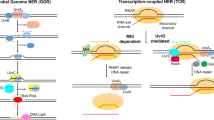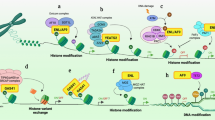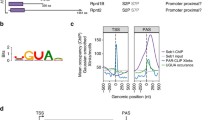Abstract
Background
Transcription elongation is a dynamic and tightly regulated step of gene expression in eukaryotic cells. Eleven nineteen Lysine rich Leukemia (ELL) and ELL Associated Factors (EAF) family of conserved proteins are required for efficient RNA polymerase II-mediated transcription elongation. Orthologs of these proteins have been identified in different organisms, including fission yeast and humans.
Methods and Results
In the present study, we have examined the sequence, structural and functional conservation between the fission yeast and human ELL and EAF orthologs. Our computational analysis revealed that these proteins share some sequence characteristics, and were predominantly disordered in both organisms. Our functional complementation assays revealed that both human ELL and EAF proteins could complement the lack of ell1+ or eaf1+ in Schizosaccharomyces pombe respectively. Furthermore, our domain mapping experiments demonstrated that both the amino and carboxyl terminal domains of human EAF proteins could functionally complement the S. pombe eaf1 deletion phenotypes. However, only the carboxyl-terminus domain of human ELL was able to partially rescue the phenotypes associated with lack of ell1+ in S. pombe.
Conclusions
Collectively, our work adds ELL-EAF to the increasing list of human-yeast complementation gene pairs, wherein the simpler fission yeast can be used to further enhance our understanding of the role of these proteins in transcription elongation and human disease.
















Similar content being viewed by others
References
Jonkers I, Lis JT (2015) Getting up to speed with transcription elongation by RNA polymerase II. Nat Rev Mol Cell Biol 16:167–177
Kwak H, Lis JT (2013) Control of transcriptional elongation. Annu Rev Genet 47:483–508
Shilatifard A (1998) Factors regulating the transcriptional elongation activity of RNA polymerase II. FASEB J 12:1437–1446
Sims RJ, Belotserkovskaya R, Reinberg D (2004) Elongation by RNA polymerase II: the short and long of it. Genes Dev 8:2437–2468
Shilatifard A, Conaway JW, Conaway RC (1997) Mechanism and regulation of transcriptional elongation and regulation of transcriptional elongation and termination by RNA polymerase II. Genetics Dev 7:199–204
Thirman MJ, Levitan DA, Kobayashi H, Simon MC, Rowley JD (1994) Cloning of ELL, a gene that fuses to MLL in at (11;19)(q23;p13.1) in acute myeloid leukemia. Proc Natl Acad Sci 91:12110–12114
Shilatifard A, Duan DR, Haque D, Florence C, Schubach WH, Conaway JW, Conaway RC (1997) ELL2, a new member of an ELL family of RNA polymerase II elongation factors. Proc Natl Acad Sci 94:3639–3643
Miller T, Williams K, Johnstone RW, Shilatifard A (2000) Identification, cloning, expression, and biochemical characterization of the testis-specific RNA polymerase II elongation factor ELL3. J Biol Chem 275:32052–32056
Shilatifard A, Lane WS, Jackson KW, Conaway RC, Conaway JW (1996) An RNA polymerase II elongation factor encoded by the human ELL gene. Science 271:1873–1876
Simone F, Polak PE, Kaberlein JJ, Luo RT, Levitan DA, Thirman MJ (2001) EAF1, a novel ELL-associated factor that is delocalized by expression of the MLL-ELL fusion protein. Blood 98:201–209
Simone F, Luo RT, Polak PE, Kaberlein JJ, Thirman MJ (2003) ELLassociated factor 2 (EAF2), a functional homolog of EAF1 with alternative ELL binding properties. Blood 101:2355–2362
Kong SE, Banks CAS, Shilatifard A, Conaway JW, Conaway RC (2005) ELL-associated factors 1 and 2 are positive regulators of RNA polymerase II elongation factor ELL. Proc Natl Acad Sci 102:10094–10098
Dimartino JF, Miller T, Ayton PM, Landewe T, Hess JL, Cleary ML, Shilatifard A, Dc W (2000) A carboxy-terminal domain of ELL is required and sufficient for immortalization of myeloid progenitors by MLL-ELL. Blood 96:3887–3893
Luo RT, Lavau C, Du C, Simone F, Polak PE, Kawamata S, Thirman MJ (2001) The elongation domain of ELL is dispensable but its ELL-associated factor 1 interaction domain is essential for MLL-ELL-induced leukemogenesis. Mol Cell Biol 21:5678–5687
Su F, Correa BRS, Luo J, Vencio RZN, Pascal LE, Wang Z (2013) Gene expression profiling reveals regulation of ERK phosphorylation by androgen-induced tumor suppressor U19/EAF2 in the mouse prostate. Cancer Microenviron 6:247–261
Ai J, Pascal LE, O’Malley KJ, Dar JA, Isharwal S, Qiao Z, Ren B, Rigatti LH, Dhir R, Xiao W, Nelson JB, Wang Z (2014) Concomitant loss of EAF2/U19 and Pten synergistically promotes prostate carcinogenesis in the mouse model. Oncogene 33:2286–2294
Qiao Z, Wang D, Hahn J, Ai J, Wang Z (2014) Pirin down-regulates the EAF2/U19 protein and alleviates its growth inhibition in prostate cancer cells. Prostate 74:113–120
Zang Y, Dong Y, Yang D, Xue B, Li F, Gu P, Zhao H, Wang S, Zhou S, Ying R, Wang Z, Shan Y (2016) Expression and prognostic significance of ELL-associated factor 2 in human prostate cancer. Int Urol Nephrol 48:695–700
Eissenberg JC, Ma J, Gerber MA, Christensen A, Kennison JA, Shilatifard A (2002) dELL is an essential RNA polymerase II elongation factor with a general role in development. Proc Natl Acad Sci 99:9894–9899
Gerber M, Ma J, Dean K, Eissenberg JC, Shilatifard A (2001) Drosophila ELL is associated with actively elongating RNA polymerase II on transcriptionally active sites in vivo. EMBO J 20:6104–6114
Smith ER, Winter B, Eissenberg JC, Shilatifard A (2008) Regulation of the transcriptional activity of poised RNA polymerase II by the elongation factor ELL. Proc Natl Acad Sci 105:8575–8579
Cai L, Phong BL, Fisher AL, Wang Z (2011) Regulation of fertility, survival, and cuticle collagen function by the Caenorhabditis elegans eaf-1 and ell-1 genes. J Biol Chem 286:35915–35921
Zhou J, Feng X, Ban B, Liu J, Wang Z, Xiao W (2009) Elongation factor ELL (Eleven-Nineteen Lysine-rich Leukemia) acts as a transcription factor for direct thrombospondin-1 regulation. J Biol Chem 284:19142–19152
Thirman MJ, Diskin EB, Bin SS, Ip HS, Miller JM, Simon MC (1997) Developmental analysis and subcellular localization of the murine homologue of ELL. Proc. Nat1. Acad Sci 4:1408–1413
Banks CA, Kong SE, Spahr H, Florens L, Martin-Brown S, Washburn MP, Conaway JW, Mushegian A, Conaway RC (2007) Identification and characterization of a Schizosaccharomyces pombe RNA polymerase II elongation factor with similarity to the metazoan transcription factor ELL. J Biol Chem 282:5761–5769
Hu B, Zhang W, Feng X, Ji W, Xie X, Xiao W (2014) Zebrafish eaf1 suppresses foxo3b expression to modulate transcriptional activity of gata1 and spi1 in primitive hematopoiesis. Dev Biol 388:81–93
Sweta K, Dabas P, Jain K, Sharma N (2017) The amino-terminal domain of ELL transcription elongation factor is essential for ELL function in Schizosaccharomyces pombe. Microbiology 163:1641–1653
Dabas P, Sweta K, Ekka M, Sharma N (2018) Structure Function Characterization of the ELL Associated Factor (EAF) from Schizosaccharomyces pombe. Gene 641:117–128
Gopalan S, Gibbon DM, Banks CAS, Zhang Y, Florens L, Washburn MP, Preeti D, Nimisha S, Christopher WS, Conaway RC, Conaway JW (2018) Schizosaccharomyces pombe Pol II transcription elongation factor ELL functions as part of a rudimentary super elongation complex. Nucleic Acids Res 46:10095–10105
Hamza A, Tammpere E, Kofoed M, Keong C, Chiang J, Giaever G, Nislow C, Philip Hieter P (2015) Complementation of Yeast Genes with Human Genes as an Experimental Platform for Functional Testing of Human Genetic Variants. Genetics 201:1263–1274
Yang F, Sun S, Tan G, Costanzo M, Hill DE, Vidal M, Andrews BJ, Boone C, Roth FP (2017) Identifying pathogenicity of human variants via paralog-based yeast complementation. PLoS Genet 13(5):e1006779
Laurent JM, Garge RK, Teufel AI, Wilke CO, Kachroo AH, Marcotte EM (2020) Humanization of yeast genes with multiple human orthologs reveals functional divergence between paralogs. PLoS Biol 18(5):e3000627
Castresana J (2000) Selection of conserved blocks from multiple alignments for their use in phylogenetic analysis. Mol Biol Evol 17:540–552
Crooks GE, Hon G, Chandonia JM, Brenner SE (2004) WebLogo: a sequence logo generator. Genome Res 14(6):1188–1190
Kosugi S, Hasebe M, Entani T, Takayama S, Tomita M, Yanagawa H (2008) Design of peptide inhibitors for the importin α/β nuclear import pathway by activity-based profiling. Chem Biol 15:940–949
Pagni M, Ioannidis V, Cerutti L, Zahn-Zabal M, Jongeneel CV, Hau J, Martin O, Kuznetsov D, Falquet L (2007) MyHits: improvements to an interactive resource for analyzing protein sequences. Nucleic Acids Res 35(W433–7):37
Hulo N, Bairoch A, Bulliard V, Cerutti L, De Castro E, Langendijk-Genevaux PS, Pagni M, Sigrist CJ (2006) The PROSITE database. Nucleic Acids Res 34:D227–D230
Jumper J, Evans R, Pritzel A, Green T, Figurnov M et al (2021) Highly accurate protein structure prediction with AlphaFold. Nature 596:583–589
McGuffin LJ, Bryson K, Jones DT (2000) The PSIPRED protein structure prediction server. Bioinformatics 4:404–405
Piovesan D, Tabaro F, Paladin L, Necci M, Mičetić I, Camilloni C, Davey N, Dosztányi Z, Mészáros B, Monzon AM, Parisi G (2018) MobiDB 3.0: more annotations for intrinsic disorder, conformational diversity and interactions in proteins. Nucleic Acids Res 46:D471–D476
Shilatifard A, Haque D, Conaway RC, Conaway JW (1997) Structure and function of RNA polymerase II elongation factor ELL. Identification of two overlapping ELL functional domains that govern its interaction with polymerase and the ternary elongation complex. J Biol Chem 272:22355–22363
Liu J, Perumal NB, Oldfield CJ, Su EW, Uversky VN, Dunker AK (2006) Intrinsic disorder in transcription factors. Biochemistry 45:6873–6888
Staby L, Shea CO, Willemoes M, Theisen F, Kragelund BB, Skriver K (2017) Eukaryotic transcription factors: paradigms of protein intrinsic disorder. Biochem J 474:2509–2532
Zhou H, Liu Q, Shi T, Yu Y, Lu H (2015) Genome-wide screen of fission yeast mutants for sensitivity to 6-azauracil, an inhibitor of transcriptional elongation. Yeast 32:643–655
Uversky VN (2015) The intrinsic disorder alphabet. III. Dual personality of serine. Intrinsically Disord Proteins 3(1):e1027032
Smith ER, Lin C, Garrett AS, Thornton J, Mohaghegh N, Hu D, Jackson J, Saraf A, Swanson SK, Seidel C, Florens L (2011) The little elongation complex regulates small nuclear RNA transcription. Mol Cell 44(6):954–965
Johnstone RW, Gerber M, Landewe T, Tollefson A, Wold WS, Shilatifard A (2001) Functional analysis of the leukemia protein ELL: evidence for a role in the regulation of cell growth and survival. Mol Cell Boil 21(5):1672–1681
Acknowledgements
The authors thank Prof. Susan Forsburg (University of Southern California, USA), Prof. Richard Maraia (National Institutes of Health, USA), Dr. Joan Conaway (Stowers Institute for Medical Research, USA) and Prof. Antony Carr (University of Sussex, UK) for kindly providing yeast strains and plasmids used in this work. The authors would also like to thank Dr Swati Tiwari (Jawaharlal Nehru University, India) for the generous gift of anti-HA antibody. This work was funded by a grant from the Department of Biotechnology, Govt. of India (Grant No. BT/PR12568/BRB/10/1369/2015). P.D was supported by a fellowship from University Grants Commission, Government of India and Guru Gobind Singh Indraprastha University (STRF).
Author information
Authors and Affiliations
Contributions
KS and PD performed all experiments. KS, PD and NS contributed in designing the experiments, analyzing and interpreting the data. All authors were involved in writing the manuscript. NS conceptualized the study and procured funding for this work.
Corresponding author
Ethics declarations
Conflict of interest
The authors declare that they have no conflict of interest with the contents of this article.
Consent to participate
Not applicable.
Consent to publish
All authors have approved to publish this work.
Ethical approval
Not applicable.
Additional information
Publisher's Note
Springer Nature remains neutral with regard to jurisdictional claims in published maps and institutional affiliations.
Supplementary Information
Below is the link to the electronic supplementary material.
Rights and permissions
About this article
Cite this article
Sweta, K., Dabas, P. & Sharma, N. Sequence, structural and functional conservation among the human and fission yeast ELL and EAF transcription elongation factors. Mol Biol Rep 49, 1303–1320 (2022). https://doi.org/10.1007/s11033-021-06958-x
Received:
Accepted:
Published:
Issue Date:
DOI: https://doi.org/10.1007/s11033-021-06958-x




